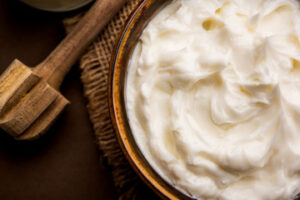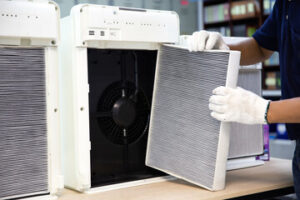With a dreamy, whipped texture, this Body Butter softens and revitalizes skin with coconut, murumuru, and vegan squalane. It is also made without harmful ingredients like parabens, phthalates, or sulfates.
Use this body butter right after your shower or bath and pay special attention to areas prone to dryness, such as elbows, knees, hands, and feet.

1. Moisturizes Skin
Body Butter is a rich moisturizer that locks in moisture, leaving skin soft and smooth. It is typically made from shea and cocoa butter and infused with essential oils that are known for their nourishing and moisturizing properties. These ingredients are naturally anti-inflammatory, antioxidant-rich and packed with vitamin E to nourish skin and improve its elasticity. They also contain jojoba oil that closely resembles your natural sebum, helping to balance your skin’s oil production.
Compared to lotion, body butter is much thicker and offers deeper moisturizing. It may take a little longer to absorb into your skin, but the extra time is well worth it as it leaves you with softer, supple and hydrated skin. It is also great for dry skin types and drier parts of the body, like the hands and feet.
Applying a rich moisturizer to your skin daily helps protect it from damaging free radicals that can cause wrinkles and fine lines. It also keeps your skin hydrated and prevents stretch marks. If you are prone to stretch marks, try applying body butter throughout the day as a preventative measure. It is best to do this before you go to bed at night to allow your skin to fully absorb the moisturizer and prepare for a good night’s rest.
The natural oils and butters found in body butter help to soothe irritated skin, as well as reduce redness and itchiness. The nourishing nutrients help restore your skin’s natural balance and hydrate it from the inside out, leaving it feeling smooth and silky.
Body Butter is a great moisturizer for dry skin types, as it can help moisturize your entire body, while also softening rough and dry areas of the skin, like your knees and elbows. It’s important to remember that you should apply your body butter within a few minutes of getting out of the shower, as this will lock in the most moisture. You can also try using it before bed at night as an intensive overnight treatment to really give your skin a deep moisturizer. Whish’s all-natural body butter is perfect for this and is available in pomegranate, lemongrass, lavender, and coconut.
2. Helps Prevent Stretch Marks
Stretch marks are a common concern for many people. Whether caused by rapid weight gain or loss, pregnancy, or growth spurts during puberty, they can leave behind silvery scarring on the skin that affects confidence and body image. Fortunately, there are ways to minimize the appearance of existing stretch marks and prevent them from developing in the first place, such as applying Shea Butter regularly to keep skin healthy and hydrated.
Shea Butter, especially when unrefined, unbleached and raw, is rich in antioxidants, phytosterols, essential fatty acids, and vitamins A & E, all of which help to improve skin elasticity and reduce the appearance of stretch marks. In addition, shea butter is safe for pregnant women to use and does not contain harmful chemicals or additives.
When applied to the skin, shea butter can help to stimulate fibroblastic activity and enhance the production of collagen and elastin. These are the protein fibers that are responsible for skin elasticity, and by increasing their production, they can help to decrease the appearance of stretch marks and prevent them from developing in the future.
While stretch marks are completely normal and happen to most expecting moms, using a moisturizing shea butter can help to improve the skin’s elasticity so it is less likely to develop them. When selecting a shea butter to add to your routine, look for one that is free of harmful additives, and instead contains natural ingredients like jojoba oil (which closely resembles the skin’s own sebum) and sunflower oil.
Another great tip for preventing stretch marks is to apply body butter liberally straight out of the shower. This will seal in the moisture and allow it to absorb quickly before the skin loses its softness. It is also important to massage the butter into the skin with light, circular motions so it can reach every inch of your body. Don’t forget to focus on the areas that are more prone to stretch marks, such as your stomach, hips, thighs, and breasts. By incorporating body butter into your daily routine, you can help to prevent stretch marks and feel confident in the way that you look.
3. Hydrates Skin for a Longer Life
Body butter is similar to body lotion, but is richer and has a heavier texture. It hydrates the skin for a long time and makes it soft and supple. This makes it a great option to moisturize dry winter skin. The natural oils and shea butter in a body butter help to seal in the moisture and provide a protective barrier for your skin. Regular application of body butter also helps to prevent stretch marks.
The best time to apply body butter is immediately after showering. While the skin is damp, dispense a small amount of body butter into your hands and rub it into your skin. Make sure you don’t over do it, as a little goes a long way. You can also apply it before you go to bed. This is a good idea because it will lock in the moisture all night, leaving you with hydrated skin when you wake up.
You can also use body butter on problem areas that are prone to drying out such as your knees, elbows and feet. This will give them a boost of moisture and help to protect your skin against itchiness and cracking.
A body butter is often scented with essential oils and other skin-friendly ingredients. These are then combined to create a deep moisturizing formula. Most body butters are made with shea butter and cocoa butter, which add to the hydration of your skin and provide a pleasant scent.
The most important thing to remember when using body butter is to apply it regularly. If you are not applying it daily, it will not hydrate your skin properly and will not prevent stretch marks. You should apply it twice a day or at least once to keep your skin hydrated and prevent dryness.
If you are looking for a natural body butter that is packed with nutrients, check out Celestolite’s Revitalizing Body Butter. It is formulated with shea and cocoa butter, as well as other skin-friendly ingredients that are beneficial to your skin health. It is a natural and luxurious product that will leave your skin feeling soft, supple, and beautiful.
4. Great for Sensitive Skin
If you have sensitive skin, body butter is a great way to replenish moisture and keep your complexion looking smooth and healthy. It can also help you ease the appearance of redness, puffiness, itchiness, and other common skin conditions. Body butters typically contain a combination of naturally derived oils and butters like cocoa, shea, or mango butter. They are usually prepared using the double boiler method and may also include essential oils for a light scent. They are then whipped until they become lighter and fluffier.
The best Body Butter for Sensitive Skin is often made with plant-based ingredients that are gentle and soothing. Shea butter, for example, has a natural nutty fragrance and is known to soothe dry and irritated skin. It is also rich in vitamins, antioxidants, and fatty acids, which can improve skin elasticity and reduce the appearance of stretch marks. Jojoba and sunflower oils are another excellent choice for sensitive skin. These oils are hydrating and contain a high amount of Vitamin E, which can protect your skin from free radical damage.
You can also make your own Body Butter at home, which is a great option if you are concerned about the ingredients used in commercial products. You can even add in oil-based extracts, such as chamomile or lavender, for added benefits. You can also use powdered colorants to give your Body Butter a fun hue.
To use body butter, start with clean and dry skin. Apply a small amount of the product to your fingertips and then massage it into your skin until it is fully absorbed. Apply extra attention to problem areas like your elbows, heels, and palms. Once you are finished, pat your skin dry with a soft towel to lock in the moisture.
You can also apply body butter to your feet before putting on socks at night. This will help to hydrate your skin while you sleep and will also prevent cracking and peeling. You can even use a body butter infused with lavender to help you relax before bedtime. It’s important to remember that while many body butters are gentle, it is always a good idea to perform a patch test before you start using it regularly.

